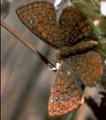Native Plants
Search for native plants by scientific name, common name or family. If you are not sure what you are looking for, try the Combination Search or our Recommended Species lists.
Cirsium horridulum
Cirsium horridulum Michx.
Bristle Thistle, Yellow Thistle, Horrid Thistle, Purple Thistle, Spiny Thistle, Bull Thistle
Asteraceae (Aster Family)
Synonym(s):
USDA Symbol: CIHO2
USDA Native Status: L48 (N)
A tall branching stem with large yellowish or red-purple flower heads and very spiny, clasping leaves. It usually grows 2 to 5-1/2 feet tall, and the leaves are 8-24 inches long. In rare instances the blossom is pale yellow to almost white.
Often found along the edges of salt marshes, it is also a pasture weed in the South, where it is frequently red-purple instead of yellow. Prairie Thistle (C. canescens) also yellow, has leaves white and velvety beneath and grayish above, with leaf bases extending, wing-like, down the stem. It is typical of overgrazed western pastures.
Plant Characteristics
Duration: AnnualHabit: Herb
Size Notes: Up to about 8 feet tall, often much shorter.
Fruit: Fruit is a cypsela (pl. cypselae). Though technically incorrect, the fruit is often referred to as an achene.
Bloom Information
Bloom Color: White , Red , Pink , Yellow , PurpleBloom Time: May , Jun , Jul , Aug
Bloom Notes: Sometimes pale yellow to almost white. Flower color varies greatly.
Distribution
USA: AL , AR , CT , DE , FL , GA , LA , MA , MD , ME , MS , NC , NH , NJ , NV , NY , OK , PA , RI , SC , TN , TX , VANative Distribution: Coastal Plain from southern Maine to Florida; west to Texas.
Native Habitat: Shores, marshes, sandy or peaty fields.
Value to Beneficial Insects
Special Value to Native BeesSpecial Value to Bumble Bees
Provides Nesting Materials/Structure for Native Bees
This information was provided by the Pollinator Program at The Xerces Society for Invertebrate Conservation.
Butterflies and Moths of North America (BAMONA)
|
Little Metalmark (Calephelis virginiensis)  Larval Host |
Mr. Smarty Plants says
Native host plants for Painted Lady Butterfly
June 01, 2006
I am looking for host plants for the Painted Lady Butterfly that I can plant in my school's (I am a teacher) native plant/butterfly garden. As part of the curriculum, each spring the 1st grade raises...
view the full question and answer
National Wetland Indicator Status
| Region: | AGCP | AK | AW | CB | EMP | GP | HI | MW | NCNE | WMVE |
| Status: | FAC | FACU | FAC | FACU |
From the National Organizations Directory
According to the species list provided by Affiliate Organizations, this plant is on display at the following locations:Stengl Biological Research Station - Smithville, TX
Wildflower Center Seed Bank
LBJWC-1161 Collected 2008-04-29 in Harrison County by Lady Bird Johnson Wildflower CenterBibliography
Bibref 1186 - Field Guide to Moths of Eastern North America (2005) Covell, C.V., Jr.Bibref 1185 - Field Guide to Western Butterflies (Peterson Field Guides) (1999) Opler, P.A. and A.B. Wright
Bibref 248 - Texas Wildflowers: A Field Guide (1984) Loughmiller, C. & L. Loughmiller
Bibref 328 - Wildflowers of Texas (2003) Ajilvsgi, Geyata.
Search More Titles in Bibliography
Web Reference
Webref 38 - Flora of North America (2019) Missouri Botanical Garden, St. Louis, MO & Harvard University Herbaria, Cambridge, MA.Webref 23 - Southwest Environmental Information Network (2009) SEINet - Arizona Chapter
Additional resources
USDA: Find Cirsium horridulum in USDA PlantsFNA: Find Cirsium horridulum in the Flora of North America (if available)
Google: Search Google for Cirsium horridulum
Metadata
Record Modified: 2022-12-05Research By: TWC Staff